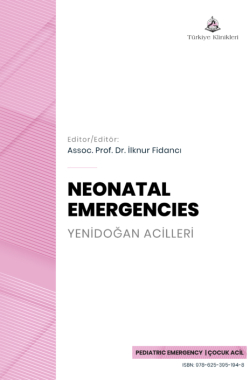Approach to Neonatal Jaundice in the Pediatric Emergency Department
Ahmet ÖKTEMa
aAnkara Dr. Sami Ulus Childrens Health and Diseases Training and Research Hospital, Department of Neonatology, Ankara, Türkiye
Öktem A. Approach to neonatal jaundice in the pediatric emergency department. In: Fidancı İ, ed. Neonatal Emergencies. 1st ed. Ankara: Türkiye Klinikleri; 2024. p.46-51.
ABSTRACT
Neonatal jaundice is one of the common causes of admission to the neonatal outpatient clinics and pediatric emergency departments. Neonatal jaundice develops as a result of the accumulation of bilirubin in the skin and mucous membranes. The imbalance between bilirubin production and conjugation causes jaundice. Early diagnosis and treatment reduces the risk of morbidity and mortality. There are biochemical tests that should be applied in the newborn presenting with jaundice. Serum bilirubin values for the decision of phototherapy or exchange transfusion are determined by charts according to postnatal age. Detailed history and physical examination are especially important for newborns who apply to the emergency department.
Keywords: Jaundice, neonatal; emergency service, hospital; phototherapy; exchange transfusion, whole blood
Kaynak Göster
Referanslar
- Hansen TWH, Bratlid D. Physiology of neonatal unconjugated hyperbilirubinemia. In: Stevenson DK, Maisels MJ, Watchko JF, eds. Care of Jaundiced Neonate. New York: McGraw-Hill, 2012. p.65-95.
- Schwarz HP, Haberman BE, Ruddy RM. Hyperbilirubinemia. Current guidelines and emerging therapies. Pediatr Emer Care. 2011; 27: 884-9. [Crossref] [PubMed]
- Maisels MJ, Kring E. The contribution of hemolysis to early jaundice in normal newborns. Pediatrics. 2006;118(1):276-9. [Crossref] [PubMed]
- Mojtahedi SY, Izadi A, Seirafi G, Khedmat L, Tavakolizadeh R. Risk Factors Associated with Neonatal Jaundice: A Cross-Sectional Study from Iran. Open Access Maced J Med Sci. 2018;6(8):1387-93. [Crossref] [PubMed] [PMC]
- American Academy of Pediatrics Subcommittee on Hyperbilirubinemia. Clinical practice guideline: management of hyperbilirubinemia in the newborn infant 35 or more weeks of gestation. Pediatrics. 2004;114(1):297-316. [Crossref] [PubMed]
- Maisels MJ. What's in a name? Physiologic and pathologic jaundice: the conundrum of defining normal bilirubin levels in the newborn. Pediatrics 2006; 118: 805-7. [Crossref] [PubMed]
- Naumova NN, Schappert J, Kaplan LA. Reducing substances in urine: a paradigm for changes in a standard test. Ann Clin Lab Sci. 2006;36(4):447-8.
- Mitra S, Rennie J. Neonatal jaundice: aetiology, diagnosis and treatment. Br J Hosp Med (Lond). 2017;78(12):699-704. [Crossref] [PubMed]
- Kasirer Y, Kaplan M, Hammerman C. Kernicterus on the Spectrum. Neoreviews. 2023;24(6):e329-e342. [Crossref] [PubMed]
- Xu JX, Lin F, Wu YH, Chen ZK, Ma YB, Yang LY. Etiology analysis for term newborns with severe hyperbilirubinemia in eastern Guangdong of China. World J Clin Cases. 2023;11(11):2443-51. [Crossref] [PubMed] [PMC]
- Le Pichon JB, Riordan SM, Watchko J, Shapiro SM. The Neurological Sequelae of Neonatal Hyperbilirubinemia: Definitions, Diagnosis and Treatment of the Kernicterus Spectrum Disorders (KSDs). Curr Pediatr Rev. 2017;13(3):199-209. [Crossref]
- Johnson L, Bhutani VK, Karp K, Sivieri EM, Shapiro SM. Clinical report from the pilot USA kernicterus registry (1992 to 2004). J Perinatol. 2009;29(Suppl 1):25-45. [Crossref] [PubMed]
- Hansen TWR, Nietsch L, Norman E, Bjerre JV, Hascoet JM, Mreihal K, et al. Reversibility of acute intermediate phase bilirubin encephalopathy. Acta Paediatr. 2009;98:1689-94. [Crossref] [PubMed]
- Amin SB, Bhutani VK, Watchko JF. Apnea in acute bilirubin encephalopathy. Semin Perinatol. 2014;38(7):407-11. [Crossref] [PubMed] [PMC]
- Ketsuwan S, Baiya N, Maelhacharoenporn K, Puapornpong P. The Association of Breastfeeding Practices with Neonatal Jaundice. J Med Assoc Thai. 2017;100(3):255-61.
- Katar S, Devecioğlu C, Özel AK, Sucaklı İ. Kan Değişimi Yapılan Yenidoğan Bebeklerde Hiperbilüribinemi Etyolojisinin Değerlendirilmesi. Dicle Tıp Dergisi. 2006;33:174-7.
- Wolff M, Schinasi DA, Lavelle J, Boorstein N, Zorc JJ. Management of neonates with hyperbilirubinemia: improving timeliness of care using a clinical pathway. Pediatrics. 2012;130(6):1688-94. [Crossref] [PubMed]
- Khajehei M, Gidaszewski B, Maheshwari R, McGee TM. Clinical outcomes and cost-effectiveness of large-scale midwifery-led, paediatrician-overseen home phototherapy and neonatal jaundice surveillance: A retrospective cohort study. J Paediatr Child Health. 2022;58(7):1159-67. [Crossref] [PubMed] [PMC]
- National Institute of Child Health and Clinical Excellence: Jaundice in newborn babies under 28 days. Erişim linki: [Link]
- Türk Neonatoloji Derneği Yenidoğan Sarılıklarında Yaklaşım, İzlem ve Tedavi Rehberi 2022 Güncellemesi. Erişim linki: [Link]
- Shinwell ES, Sciaky Y, and Karplus M. Effect of position changing on bilirubin levels during phototherapy. J Peri¬natol. 2002;22:226-9. [Crossref] [PubMed]
- Raimondi F, Maffucci R, Milite P, et al. Why should we care about neonatal hyperbilirubinemia in 2011? J Matern Fetal Neonatal Med. 2011;24:83-4. [Crossref] [PubMed]
- Girelli G, Antoncecchi S, Casadei AM, Vecchio AD, Iser¬nia P, et al. Recommendations for transfusion therapy in neonatology. Review Blood Transfus. 2015;13(3):484-97.
- Ahlfors CE, Wennberg RP, Ostrow JD, Tiribelli C. Unbound (free) bilirubin: improving the paradigm for evaluating ne¬onatal jaundice. Clin Chem. 2009; 55:1288-99. [Crossref] [PubMed]
- Wang J, Guo G, Li A, Cai WQ, Wang X. Challenges of phototherapy for neonatal hyperbilirubinemia (Review). Exp Ther Med. 2021;21(3):231. [Crossref] [PubMed] [PMC]

